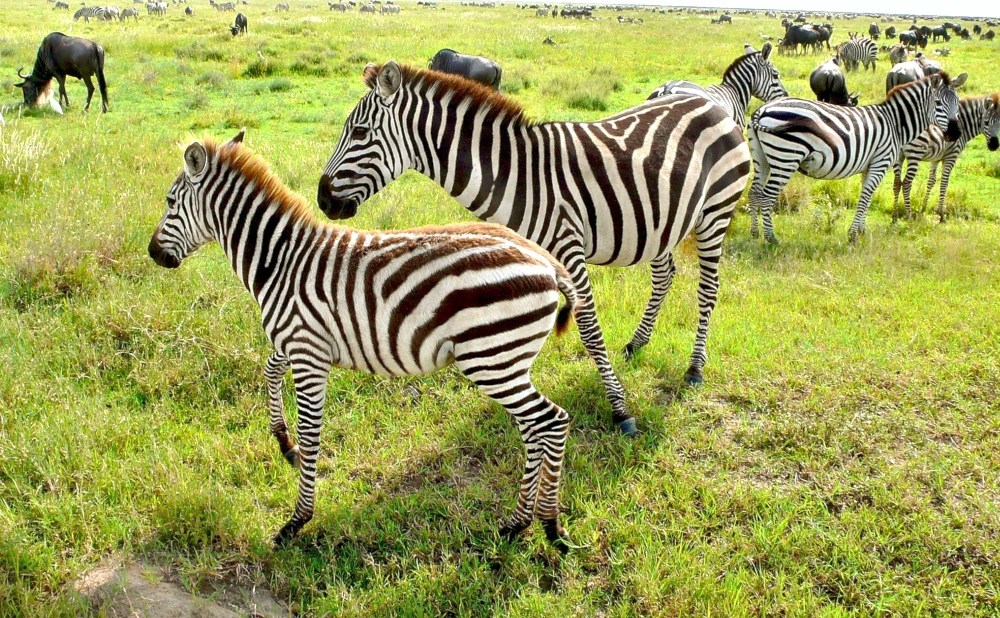Serengeti National Park
Welcome to Serengeti National Park
Known as "Siringet" by the Maasai, meaning "endless plains," Serengeti National Park offers a landscape that stretches as far as the eye can see. This world-famous destination is celebrated for hosting one of nature’s most remarkable phenomena—the Great Migration. Beyond the migration, Serengeti offers unparalleled biodiversity, captivating landscapes, and a deeply rooted cultural history, making it one of Africa’s most iconic safari destinations.
Wildlife Highlights
Serengeti is home to an extraordinary array of wildlife, providing a quintessential African safari experience:
- Wildebeest & Zebra: The park boasts the largest populations of wildebeest and zebra on Earth. Their synchronized movements form the backbone of the Great Migration, a spectacle that attracts visitors from around the globe.
- Predators: Serengeti is known for its high density of predators, including lions, leopards, cheetahs, and spotted hyenas. The opportunity to observe these powerful hunters in action—whether stalking prey or defending territory—is unforgettable.
- Herbivores: With more than 28 species, including elephants, buffalos, giraffes, hippos, and elands, herbivores add color and life to the Serengeti’s vast plains.
- Endangered Species: Serengeti provides a critical sanctuary for endangered species like the black rhinoceros and African wild dogs, offering visitors the rare chance to see these animals in the wild.
- Birdlife: The park is a bird-watcher's paradise, with over 530 recorded species, including migratory birds from Europe, Asia, and the Americas. Notable species include the fish eagle, martial eagle, secretary bird, and ostrich.
Climate and Best Time to Visit
The Serengeti’s subtropical climate varies by season:
- Rainy Season (November to April): Lush greenery blankets the plains, and wildlife is abundant. This period also marks the calving season, offering excellent opportunities to see newborn animals and predator-prey interactions.
- Dry Season (May to October): The dry months are ideal for game viewing, with animals congregating around waterholes. The migration peaks during this time, with dramatic river crossings in the northern Serengeti (July to September).
The park’s altitude ranges from 1,100 to 2,000 meters, providing cooler temperatures and an average annual rainfall of 900 to 1,000 mm.
Getting to Serengeti
By Road: Access points include major gates such as Naabi Hill, Seronera, Ndutu, Lobo, and Ndabaka. Driving from Arusha or Mwanza provides an adventurous way to explore the surrounding countryside.
By Air: Several airstrips serve different regions of the park:
- Central: Seronera Airstrip
- South: Kusini Airstrip
- North: Kogatende and Lamai Airstrips
- West: Kirawira Airstrip
Daily flights from Arusha, Mwanza, Kilimanjaro, Dar es Salaam, and Zanzibar make flying a convenient option for those short on time.
Top Attractions
- The Great Migration: Witness over 1.3 million wildebeest, along with thousands of zebras, elands, and gazelles, as they embark on their annual journey in search of fresh grazing. Key highlights include the Mara River crossings in the north and calving season in the south.
- The Big Five: Serengeti offers the chance to spot Africa’s Big Five—lion, leopard, elephant, buffalo, and rhino—making it a prime destination for wildlife enthusiasts.
- Cultural and Historical Sites: Visit Maasai Rock Paintings, Gong Rock, and Ikoma ruins to delve into the rich history of the indigenous Maasai, Sukuma, and Kurya tribes.
- Scenic Landscapes: From sweeping grasslands to rocky kopjes, Serengeti’s diverse landscapes offer spectacular photo opportunities, particularly during sunrise and sunset.
- Flora & Fauna: During the rainy season, wildflowers bloom, attracting colorful butterflies and a wide variety of insects, providing a haven for botanists and entomologists.
Activities
Serengeti offers a range of activities tailored to every visitor’s preference:
- Hot Air Balloon Safari: Glide over the endless plains at sunrise for a bird’s-eye view of the wildlife below, followed by a champagne breakfast.
- Game Drives: Morning, afternoon, and full-day game drives provide close-up encounters with Serengeti’s diverse wildlife.
- Walking Safaris: Immerse yourself in the wilderness on foot, guided by expert rangers for a deeper connection with nature.
- Bush Meals: Enjoy a gourmet meal in the heart of the bush, surrounded by stunning landscapes and wildlife.
- Cultural Tours: Engage with local Maasai communities to learn about their traditions, rituals, and way of life.
- Filming & Photography: Serengeti’s breathtaking scenery and abundant wildlife make it a dream location for filmmakers and photographers.
Accommodation Options
Whether you seek luxury or a more rustic experience, Serengeti offers a variety of accommodations:
- Luxury Lodges: Indulge in top-tier amenities and unparalleled service with stunning views of the plains.
- Tented Camps: Experience the magic of the African wilderness without sacrificing comfort.
- Campsites: For the adventurous, public and private campsites offer a closer connection to nature.
TANAPA (Tanzania National Parks Authority) manages public, special, and seasonal campsites, ensuring a range of options to suit all preferences.
Plan your adventure to Serengeti National Park today and experience the wild like never before!

